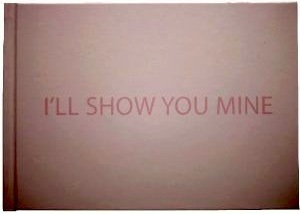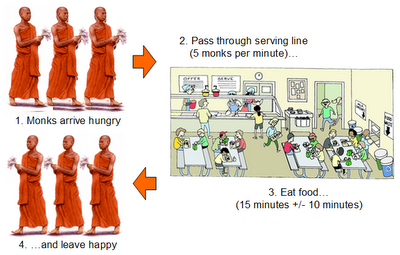Marc Abrahams's Blog, page 563
July 8, 2012
Is Vulvar Vulgar? Whither, (withered?) and when
Vulvas get a good look in this soon-to-be-published study:
“Interest in Cosmetic Vulvar Surgery and Perception of Vulvar Appearance,” Ladin A. Yurteri-Kaplan, Danielle D. Antosh, Andrew I. Sokol, Amy J. Park, Robert E. Gutman, Sheryl A. Kingsberg, Cheryl B. Iglesia [pictured here], in press at American Journal of Obstetrics & Gynecology. The authors are variously at Georgetown University School of Medicine, Washington, DC, and Case Western Reserve University School of Medicine in Cleveland, Ohio. They write:
Objective: To determine if reproductive-age women are more likely to perceive their vulva as abnormal compared to older aged women.
Study Design: Women ages 18-44 (Group 1) and 45-72 (Group 2) completed a survey on demographics, grooming patterns, vulvar perceptions, and source of information about the vulva.
Results: There was no difference between Group 1 and Group 2 in how often women looked at their vulva or their perception of having a normal vulva (91% vs. 93%, p=0.76). Both groups were satisfied with the appearance of their vulva (81% vs. 82%, p=0.71).
The study carries this statement: “Age does not impact vulvar perception or satisfaction; however, older women more frequently consider cosmetic vulvar surgery.” The study also includes many photographs.
BONUS: ”Age cannot wither her, nor custom stale her infinite variety”
(Thanks to investogator Ivan Oransky for bringing this to our attention.)
BONUS: The document lists possible vulva-related conflicts of interest for one of the co-authors. Specifically: “Disclosures: Sheryl A. Kingsberg serves as consultant for Boehringer-Ingelheim Pharmaceuticals, Inc.; BioSante Pharmaceuticals; Pfizer, Inc.; Trimel BioPharm Inc.; Novo Nordisk; and Sprout. She is on the scientific advisory board for Viveve. She is a clinical investigator for Palatin and BioSante. She owns stock in Viveve. No other authors have any conflicts of interest.”
BONUS: “A Whole Book Of Beautiful, Diverse Vaginas“. The book is Wrenna Robertson‘s I’ll Show You Mine:

Modeling monks and a cafeteria (hydrology)
Tom Pagano explains “how to model monks going in and out of a cafeteria and how it is like a hydrological model“:
The classic analogy for hydrology models is that soils hold and release water like a series of leaky buckets. But instead, let’s start by discussing how to model a cafeteria/mess hall/canteen for hungry meditating monks….
(Thanks to investigator Brandon Treese for bringing this to our attention.)

July 7, 2012
Kees Moeliker: How a dead duck changed my life
The TED Talks people asked Kees Moeliker to do a talk about his Ig Nobel Prize-winning study, “The First Case of Homosexual Necrophilia in the Mallard Anas platyrhynchos (Aves: Anatidae)” [published in Deinsea, vol. 8, 2001, pp. 243-7]. He also talked about what happened after that study was published.
Here is the talk:
BONUS: The Le Monde newspaper report “L’étrange cas du canard homosexuel nécrophile“

July 6, 2012
Psychological Truth(s)
This is how professor Richard Feynman, BSc., Ph.D. described the process of validating a scientific proposition – which he liked to call “A guess”.
“It doesn’t make any difference how beautiful your guess is, it doesn’t make any difference how smart you are, who made the guess, or what his name is – if it disagrees with experiment, it’s wrong. That’s all there is to it.” [source]
Others have referred to this idea as The Correspondence Theory of Truth, i.e. when the ‘guess’ ‘corresponds’ to real-world observations. In other words :
“… a proposition is true if and only if the world is as the proposition says it is.”
Some may view the theory’s proposal as self-evident in the realm of say, particle physics - but how might it be applied to less concrete scientific fields such as, for example, psychology? A new paper on this subject is published in the journal Theory & Psychology, June 2012, vol. 22, no. 3, pp. 272-289.
‘Truth, science, and psychology’ is authored by professor Brian D. Haig, DipTchg, M.A. ,Ph.D. F.N.Z.Ps.S., F.A.P.S. (University of Canterbury) and professor Denny Borsboom M.A., Ph.D. (University of Amsterdam) who adopt the Correspondence Theory as a plausible theory of truth, and relate it to science. After outlining the theory, they go on to describe its implications in simple terms, thus :
“We [then] present the correspondence theory in a form that enables us to show that the theory uniquely fulfills a crucial function in psychological research, because the interpretation of truth claims as suppositions that concern states of affairs in the world clearly explicates what it means for a theory to be true, and what it means for a theory to be false.”
[tip: read 'claims' as a noun rather than a verb.]
And, to sum up, even more simply :
“It is concluded that correspondence truth plays an important part in our understanding of science, including psychology.”

A Cows-Foot Bone Stuck in Her Esophagus
This may be the only published medical account of how to remove a cows-foot bone that’s stuck in a patient’s esophagus:
“A Foreign Body Larger Than the Overtube Diameter: A Case of a Large Cow Foot Bone Causing Esophageal Impaction,” Arun Swaminath, MD, Aimee Lee Lucas, MD, Kristina Capiak, BFA, Amrita Sethi, MD, and Reuben Garcia-Carrasquillo, MD, Gastroenterology and Hepatology, 2010 December; 6(12): 793–795. The authors, at Columbia University Presbyterian Hospital, New York City, report:
“A 46-year-old, otherwise healthy Dominican woman presented with a foreign body sensation. She had been eating cow foot soup, which contains small pieces of cow foot occasionally made with intact bones, when she felt a large bone become stuck in the back of her throat. She attempted to remove the bone with her fingers but eventually swallowed it. The patient immediately felt a sharp, sticking sensation in her neck and presented to the emergency department for evaluation…. Dedicated neck films demonstrated a large radiopaque foreign body lodged in the cervical esophagus. To our knowledge, this case is the first report in the literature describing esophageal impaction of a cow foot bone with a description of the retrieval process.”
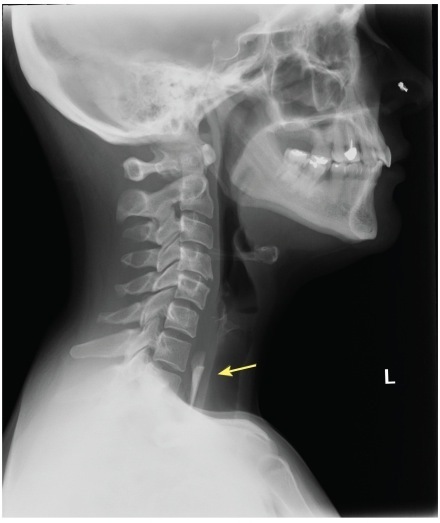
BONUS: Her (a different her) Hairball Came from Eating Cows-Feet Soup

July 5, 2012
Her Hairball Came from Eating Cows-Feet Soup
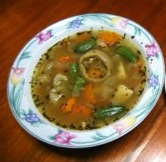
A bowl of cows-feet soup, as pictured on the Grace Kennedy web site, which also provides a recipe for the soup.
Diet can contribute to the production of hairballs on a quasi-regular basis, suggests this newly published study:
“Cows-Feet Soup: A Rare Cause of Recurrent Trichobezoar,” Miles Finbar Kiernan, Sachin Kamat, and Femi Olagbaiye, BMJ Case Reports, epub July 3, 2012. The authors, at Homerton University Hospital NHS Foundation Trust, London, UK, report:
“A 45-year-old Afro-Caribbean woman attended the emergency department with worsening dysphagia, abdominal distension, abdominal pain, shortness of breath and generalised weakness. She enjoyed preparing and eating cows-feet stew and preferred to cook the meat with the hair and skin intact. On admission she had a severe microcytic anaemia and was malnourished. Abdominal x-ray and CT revealed a large gastric bezoar. At gastrotomy a foul-smelling 2.42 kg mass of hair, leathery skin and altered food were evacuated from the lesser curvature of the stomach. She had undergone the same procedure 8 years earlier to remove a similar trichobezoar. Following psychiatric review it was deemed that the patient had no underlying psychiatric condition and had full insight into why her trichobezoar had re-occurred. She made a good postoperative recovery and stopped eating cows-feet stew.”
(Thanks to investigator Kristine Danowski for bringing this to our attention.)

July 4, 2012
Vampirical science (Freese!)
The word “vampirical” used as an un-admiring description of a scientific claim, has been credited to Jeremy Freese [pictured here], who wrote:
“Part of what makes the Trivers-Willard hypothesis perhaps more ‘vampirical’ than ‘empirical’—unable to be killed by mere evidence—is that the hypothesis seems so logically compelling that it becomes easy to presume that it must be true, and to presume that the natural science literature on the hypothesis is an unproblematic avalanche of supporting findings. […]
In fact, the Trivers-Willard hypothesis of adaptive sex ratio variation is not at all well established…”
—”The problem of predictive promiscuity in deductive applications of evolutionary reasoning to intergenerational transfers: Three cautionary tales“, Jeremy Freese, in Alan Booth et al., eds., Intergenerational Caregiving, 2008.
(Thanks to investigator Bill Naismith for bringing this to our attention.)
BONUS (not necessarily related): A soon-to-be-published paper by Professor Freese and Ig Nobel Prize winner Christopher (“did you see the gorilla?”) Chabris, and others:
“Most Published Genetic Associations with General Cognitive Ability are False Positives.” Chabris, Christopher, Benjamin M. Hebert, Daniel J. Benjamin, Jonathan Beauchamp, David Cesarini, Magnus Johanneson, Patrik K. E. Magnusson, Paul Lichtenstein, Craig S. Atwood, Jeremy Freese, Taissa S. Hauser, Robert M. Hauser, Nicholas Christakis, David I. Laibson. Forthcoming. Psychological Science

Vi Hart doodle-muses on the discovery of “a Higgs-like particle”
Vi Hart, she of many mathematics-related artistic innovations, muses on the announced discovery of “a Higgs-like particle:
(Thanks to investigator John Agle for bringing this to our attention.)

Predictors of 3-D Breast Kinematics during Bare-Breasted Running
A six-person research team has just released its findings about the predictors of three-dimensional breast kinematics during bare-breasted running. Details are in their singular study:
“Predictors of Three-Dimensional Breast Kinematics during Bare-Breasted Running“, Louise Ellen Wood, Jennifer White, Alexandra Milligan, Bessie Ayres, Wendy Hedger, and Joanna Scurr [pictured here], Medicine and Science in Sports and Exercise, vol. 44, no. 7, July 7, 2012, pp. 1351-7.The authors, at University of Gloucester and the University of Portsmouth, UK, report:
PURPOSE: This study aimed to analyze differences in breast kinematics between breast cup sizes during running and the ability of breast and body size measurements to explain these differences.
METHODS: Forty-eight women (A to G cup; mean ± SD: age = 26.0 ± 6.0 yr, stature = 1.667 ± 0.064 m, mass = 62.78 ± 8.24 kg) with chest sizes of 32 to 38 inches participated. Chest and breast girths, a restricted anthropometric profile, suprasternal notch to nipple distances, and body mass index were measured, and breast mass was estimated. Multiplanar relative breast displacement, velocity, and acceleration during treadmill running were then recorded. Differences in breast kinematics were compared between cup sizes before and after allometric/polynomial scaling using significant breast and body size measures.
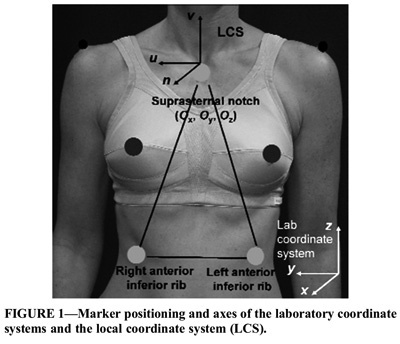
RESULTS: All kinematic variables significantly increased with breast cup size… Scaling models found that breast mass was the only anthropometric measure to consistently explain differences in breast kinematics between cup sizes.
CONCLUSIONS: Bare-breasted kinematics significantly increased with cup size during running.
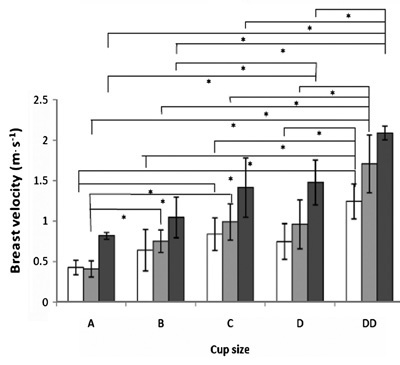
(Thanks to K.O. Lee for bringing this to our attention.)
BONUS: The treatise ”Bouncing breasts; a credible area of scientific research,” in which “Dr Joanna Scurr explains why bouncing breasts are a credible area of scientific research.” [PDF]

July 3, 2012
Quantifying ballet dancers’ leg-lift angles
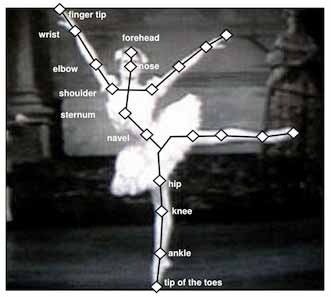 Very few scientific studies have formally investigated the angles to which ballet dancers lift their legs. But in 2009, a team from : the Dipartimento di Neuroscienze and Centro di Biomedicina Spaziale, Università degli Studi di Roma Tor Vergata, Roma, Italy, the Dipartimento di Fisiologia Neuromotoria, IRCCS Fondazione Santa Lucia, Roma, Italy, the Dipartimento di Scienze del Movimento Umano e dello Sport, Istituto Universitario di Scienze Motorie, Rome, Italy, and the Institute of Cognitive Neuroscience, University College London, UK, measured average the leg-lifting achievements of professional ballet dancers at the Royal Opera House, Covent Garden UK.
Very few scientific studies have formally investigated the angles to which ballet dancers lift their legs. But in 2009, a team from : the Dipartimento di Neuroscienze and Centro di Biomedicina Spaziale, Università degli Studi di Roma Tor Vergata, Roma, Italy, the Dipartimento di Fisiologia Neuromotoria, IRCCS Fondazione Santa Lucia, Roma, Italy, the Dipartimento di Scienze del Movimento Umano e dello Sport, Istituto Universitario di Scienze Motorie, Rome, Italy, and the Institute of Cognitive Neuroscience, University College London, UK, measured average the leg-lifting achievements of professional ballet dancers at the Royal Opera House, Covent Garden UK.
Digitally recorded body-markers were strategically positioned (by independent judges) on the dancers’ major joints and body-parts.(* see note below + image above) The results showed that the modern-day average professional leg-lift-angle is around 115 degrees – though some dancers can achieve a staggering 137 degrees. But the study goes further – for not only has the angle now been quantified, it has also been compared to previous leg-lift-angles – as registered on film showing ballet dancers performing The Sleeping Beauty from 1946 to 2004. It can now be said with some degree of confidence that the angle has been increasing substantially over the years – it was only 96 degrees in 1962. The question then arises: why? And the research team go some way towards answering it :“…we conclude that the variation in leg elevation is an example of progressive, systematic change within an artistic tradition.”
See : ‘A Dance to the Music of Time: Aesthetically-Relevant Changes in Body Posture in Performing Art ‘ in PLoS ONE 4(3): e5023. doi:10.1371/journal.pone.0005023
* note : The markers were placed with the dancers’ full permission – the study procedures having been approved by UCL’s Department of Psychology ethics committee.

Marc Abrahams's Blog
- Marc Abrahams's profile
- 14 followers


